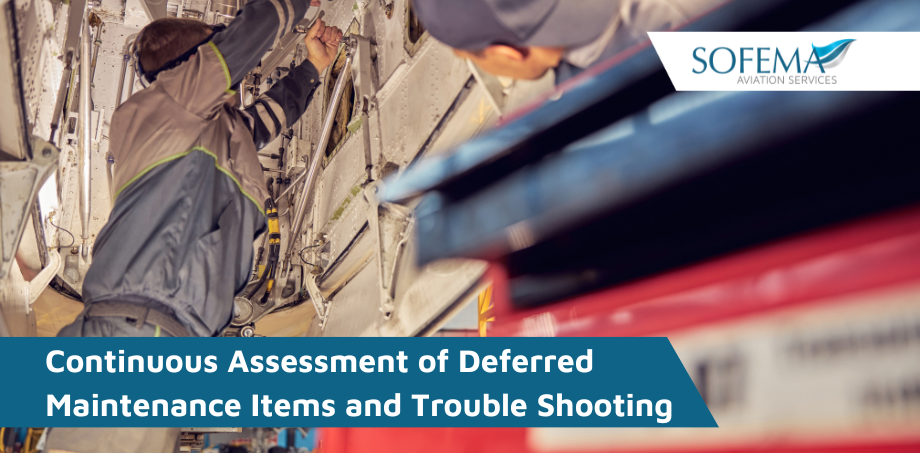Deferred Maintenance Items – Sofema Aviation Services (SAS) www.sassofia.com considers the process by which the effectiveness of the defect deferment process is assessed on a continuous basis.
Introduction
A simple measure of the effectiveness of the operation will relate to the safety and serviceability of the aircraft, the level of Technical Log or Pilot reports “PIREPs”.
- Use of the MEL is also a measure of the effectiveness of the operations, in the following context – The lower the dependence on the MEL the more effective can be considered the overall system.
- The maintenance process is driven by a multi-disciplined team of professionals. It is necessary to develop a system which pays attention to the development of the competency of all stakeholders.
Dispatch Reliability
- Dispatch Reliability (DR) is a useful measure of the overall effectiveness of the airline operation with respect to on-time departure.
- Dispatch Reliability (DR) usually receives maximum attention as it is perceived to be a measure of the “Performance” of the operator. In reality, DR can be considered as an event-oriented reliability approach whereby any departure which is delayed by over 15 mins due to technical reasons.
- DR is a simple calculation which is based on a ratio of 100 flights as a percentage. 5 delays in 100 flights would equate to a 95% dispatch rate.
An effective reliability program should identify the problems and support resolution/mitigation by identifying problems and proposing appropriate mitigations.
Case Study Concerning Categorization of Dispatch Reliability
When an airline reliability program over-focuses on dispatch reliability, the likelihood becomes that they only track and investigate problems that resulted in a delay or a cancellation of a flight. Now consider the following example:
- One hour before arrival the pilot experiences some difficulty with the Elevator Trim system on the inbound flight and writes up the defect in the Aircraft Tech Log (ATL).
- When the aircraft arrives at the line station, the maintenance crew meets the plane and checks the ATL for discrepancies.
- The maintenance engineers begin troubleshooting and repair actions. When the repair takes longer than the scheduled available turnaround time a delay will be announced.
- This Delay is allocated to Technical and identified as a Technical Delay.
- However please consider the validity of this action and:
o Did maintenance cause the delay?
o Or was the delay caused by the Elevator Trip Defect?
o Or by Ineffective Airline Procedures?
Alternative Scenario for Consideration
- For flight crew to inform maintenance concerning the Elevator Trim Defect.
- Maintenance can spend time prior to landing studying the problem and performing some initial troubleshooting analysis.
- When the aircraft lands additional maintenance resources were made available to focus on the defect.
- It is conceivable that the delay could have been minimalized with the implementation of communication and procedures changes.
Note: While the tech team could benefit from this advance warning of problems, it will not always eliminate delays.
- The important consideration is that if a delay is caused by procedural shortfall, then the delay should not be allocated to Line Maintenance Support.
Case Study Concerning Allocation of Investigation Resources and Outcomes
Whilst each technical delay will be investigated it may not identify all elements for example if an equipment failure is also involved, then how will the assessment consider this?
- If an equipment problem is involved, the investigation may or may not take into account (consider) other similar failures that did not cause delays.
- For example, if we have 6 write ups of the same problem within 1 month, however only one of these caused a delay, we have 2 problems to investigate:
o The delay, which could be caused by issues not totally dependent on the failed condition (Systemic Issues)
o The actual problem (multiple re-occurrences of a particular issue)
Conclusion
Any delay within an event-oriented reliability problem should be investigated on its own.
Investigation should also look at the whole operation & finally equipment problems whether or not they caused delays—should be investigated separately.
Next Steps
Follow this link to our Library to find & Download related support documents.
Sofema Aviation Services (www.sassofia.com) and Sofema Online (www.sofemaonline.com) offer EASA Regulatory Compliant and Vocational Training across a range of Aviation Areas – please see the following 2-day course to implement your own MCC – Defect Control Process. For additional details please see our websites or email Team@sassofia.com
Tags:
Aircraft, aviation, Aviation Maintenance, Aviation MCC, aviation safety, Aviation Training, Deferred Maintenance Items, Dispatch Reliability, MEL, Online Training, PIREPS, SAS blogs




